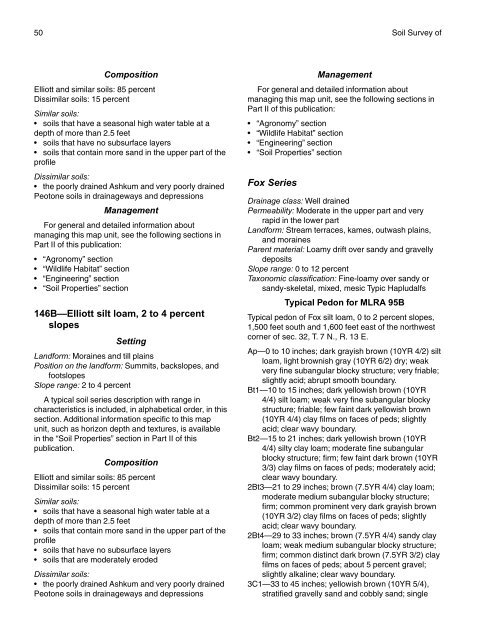Soil Survey of McHenry County, Illinois Part I - Soil Data Mart
Soil Survey of McHenry County, Illinois Part I - Soil Data Mart
Soil Survey of McHenry County, Illinois Part I - Soil Data Mart
Create successful ePaper yourself
Turn your PDF publications into a flip-book with our unique Google optimized e-Paper software.
50 <strong>Soil</strong> <strong>Survey</strong> <strong>of</strong><br />
Composition<br />
Elliott and similar soils: 85 percent<br />
Dissimilar soils: 15 percent<br />
Similar soils:<br />
• soils that have a seasonal high water table at a<br />
depth <strong>of</strong> more than 2.5 feet<br />
• soils that have no subsurface layers<br />
• soils that contain more sand in the upper part <strong>of</strong> the<br />
pr<strong>of</strong>ile<br />
Dissimilar soils:<br />
• the poorly drained Ashkum and very poorly drained<br />
Peotone soils in drainageways and depressions<br />
Management<br />
For general and detailed information about<br />
managing this map unit, see the following sections in<br />
<strong>Part</strong> II <strong>of</strong> this publication:<br />
• “Agronomy” section<br />
• “Wildlife Habitat” section<br />
• “Engineering” section<br />
• “<strong>Soil</strong> Properties” section<br />
146B—Elliott silt loam, 2 to 4 percent<br />
slopes<br />
Setting<br />
Landform: Moraines and till plains<br />
Position on the landform: Summits, backslopes, and<br />
footslopes<br />
Slope range: 2 to 4 percent<br />
A typical soil series description with range in<br />
characteristics is included, in alphabetical order, in this<br />
section. Additional information specific to this map<br />
unit, such as horizon depth and textures, is available<br />
in the “<strong>Soil</strong> Properties” section in <strong>Part</strong> II <strong>of</strong> this<br />
publication.<br />
Composition<br />
Elliott and similar soils: 85 percent<br />
Dissimilar soils: 15 percent<br />
Similar soils:<br />
• soils that have a seasonal high water table at a<br />
depth <strong>of</strong> more than 2.5 feet<br />
• soils that contain more sand in the upper part <strong>of</strong> the<br />
pr<strong>of</strong>ile<br />
• soils that have no subsurface layers<br />
• soils that are moderately eroded<br />
Dissimilar soils:<br />
• the poorly drained Ashkum and very poorly drained<br />
Peotone soils in drainageways and depressions<br />
Management<br />
For general and detailed information about<br />
managing this map unit, see the following sections in<br />
<strong>Part</strong> II <strong>of</strong> this publication:<br />
• “Agronomy” section<br />
• “Wildlife Habitat” section<br />
• “Engineering” section<br />
• “<strong>Soil</strong> Properties” section<br />
Fox Series<br />
Drainage class: Well drained<br />
Permeability: Moderate in the upper part and very<br />
rapid in the lower part<br />
Landform: Stream terraces, kames, outwash plains,<br />
and moraines<br />
Parent material: Loamy drift over sandy and gravelly<br />
deposits<br />
Slope range: 0 to 12 percent<br />
Taxonomic classification: Fine-loamy over sandy or<br />
sandy-skeletal, mixed, mesic Typic Hapludalfs<br />
Typical Pedon for MLRA 95B<br />
Typical pedon <strong>of</strong> Fox silt loam, 0 to 2 percent slopes,<br />
1,500 feet south and 1,600 feet east <strong>of</strong> the northwest<br />
corner <strong>of</strong> sec. 32, T. 7 N., R. 13 E.<br />
Ap—0 to 10 inches; dark grayish brown (10YR 4/2) silt<br />
loam, light brownish gray (10YR 6/2) dry; weak<br />
very fine subangular blocky structure; very friable;<br />
slightly acid; abrupt smooth boundary.<br />
Bt1—10 to 15 inches; dark yellowish brown (10YR<br />
4/4) silt loam; weak very fine subangular blocky<br />
structure; friable; few faint dark yellowish brown<br />
(10YR 4/4) clay films on faces <strong>of</strong> peds; slightly<br />
acid; clear wavy boundary.<br />
Bt2—15 to 21 inches; dark yellowish brown (10YR<br />
4/4) silty clay loam; moderate fine subangular<br />
blocky structure; firm; few faint dark brown (10YR<br />
3/3) clay films on faces <strong>of</strong> peds; moderately acid;<br />
clear wavy boundary.<br />
2Bt3—21 to 29 inches; brown (7.5YR 4/4) clay loam;<br />
moderate medium subangular blocky structure;<br />
firm; common prominent very dark grayish brown<br />
(10YR 3/2) clay films on faces <strong>of</strong> peds; slightly<br />
acid; clear wavy boundary.<br />
2Bt4—29 to 33 inches; brown (7.5YR 4/4) sandy clay<br />
loam; weak medium subangular blocky structure;<br />
firm; common distinct dark brown (7.5YR 3/2) clay<br />
films on faces <strong>of</strong> peds; about 5 percent gravel;<br />
slightly alkaline; clear wavy boundary.<br />
3C1—33 to 45 inches; yellowish brown (10YR 5/4),<br />
stratified gravelly sand and cobbly sand; single

















